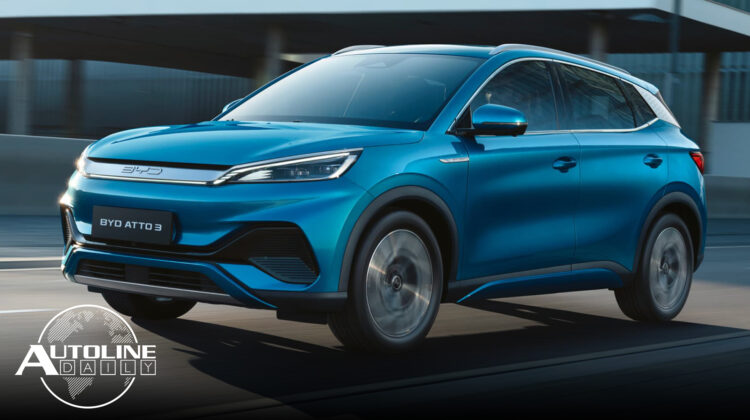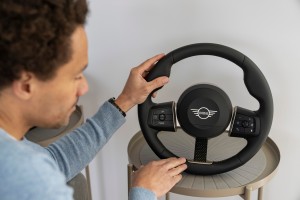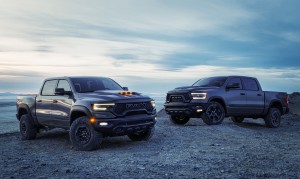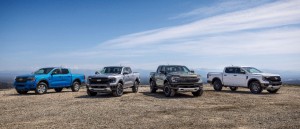
Listen to “AD #3564 – BYD, Aion Outsell Tesla in China; “BEV Factory” Leads Toyota’s EV Pivot; Ford Ranger Sets Sights on Tacoma” on Spreaker.
Follow us on social media:
Runtime: 11:57
0:00 BYD, Aion Outsell Tesla in China
1:14 “BEV Factory” Leads Toyota’s EV Pivot
3:03 Global Electric Grids Get Cleaner
5:05 Car Thefts Worse for Hyundai & Kia
6:13 Is Rivian Turning the Corner?
6:53 Mini’s Intriguing Steering Wheel Design
7:25 Ram Unveils Lunar Trim Line
8:00 Ford Ranger Sets Sights on Toyota Tacoma
Visit our sponsors to thank them for their support of Autoline Daily: Bridgestone, Intrepid Control Systems, and Schaeffler.
This is Autoline Daily, the show dedicated to enthusiasts of the global automotive industry.
BYD, AION OUTSELL TESLA IN CHINA
Tesla slipped into 3rd place in EV sales in China last month. BYD and Aion, which is a subsidiary of GAC, outsold Tesla. And BYD sold more than twice as many BEVs as Tesla did, despite Tesla slashing prices on its cars in an attempt to boost sales. Tesla actually produced almost 76,000 made-in-China vehicles last month, but the other nearly 40,000 were exported. Elon Musk told analysts last month that Tesla would prioritize sales and market share over profits. But Chinese automakers are dominating the EV segment in China, holding 8 of the top 10 sales slots. The only other foreign automaker in the Top 10 is Volkswagen, which is down in 8th place. These numbers were released by the China Passenger Car Association and reported by Car News China. By the way, these are sales of pure BEVs and do not include plug-in hybrids.
“BEV FACTORY” LEADS TOYOTA’S EV PIVOT
We now have a name for Toyota’s new dedicated EV division. It’s called the BEV Factory. It will be headed by a guy named Takero Kato, who will oversee roughly 1,000 employees. He previously ran Toyota’s Vehicle Development Center. BEV Factory will be in charge of all development, production and business related to electric vehicles and hopes to bring them out faster by bringing everything under one roof. This fiscal year alone, Toyota, including Lexus, expects to increase BEV sales to 202,000 units, up from just 38,000. In case you didn’t know, the Japanese fiscal year runs from April 1st until March 31st of the next year. BEV Factory will also show off concepts this fall that preview future models, which will ride on an all-new architecture. Those models will start arriving in 2026, by which time Toyota will have 10 all-electric models on the market and estimated sales of 1.5 million units. We find it interesting that it’s been showing off a sedan in its presentations and think Toyota could make efficiency a big focus of its next EVs. Toyota used to have a division within the company called Toyota ZEV Factory that was in charge of all things EV, but with the establishment of BEV Factory it’s being abolished and transferred to a mid-sized and commercial vehicle company. Toyota has been accused of dragging its heels in the EV transition, but this goes to show that once it makes up its mind, it can pivot really quickly.
GLOBAL ELECTRIC GRIDS GET CLEANER
The global electric grid is getting cleaner, which makes EVs even more environmentally friendly to drive. According to Ember, an independent energy think tank, CO2 emissions from power generation worldwide has fallen 11% since 2007. And wind and solar now account for 12% of power generation globally. But while countries as a whole are making progress, CO2 emissions still vary widely nation to nation. China, which relies heavily on coal for electricity, emitted 530 grams of CO2 per kWh from producing electricity last year. And in the U.S., it was 368 grams of CO2/kWh, which means driving an EV in the U.S. generates less emissions than in China. The U.S. even produces fewer CO2 emissions from power generation than Germany and Japan. But it’s still way more than Norway, which only produced 27 grams of CO2/kWh last year, thanks to hydroelectricity accounting for 90% of its power generation. And Ember says global energy production is nearing a tipping point where the growth in electricity demand is being met from renewable sources.
CAR THEFTS WORSE FOR HYUNDAI & KIA
Hyundai and Kia rolled out software earlier this year to fix an issue that allows their vehicles to be easily stolen. But the Associated Press reports that thefts continue to rise. It looked at data from seven U.S. cities that show thefts have soared year-over-year through April. And some cities say Hyundai and Kia thefts now account for 60% of stolen vehicles. Millions of models built before 2020 weren’t equipped with engine immobilizers, which prevents the vehicle from starting if the key isn’t near it. And the brands were hit with a wave of thefts after videos on social media showed how to hack those vehicles. But the rollout of the software fix has been slow. So far, Hyundai has installed it in only 225,000 of the 3.8 million Hyundai’s affected and Kia has installed it in 210,000 of its 4.5 million vehicles that need the update. Both companies say they expect to notify all owners of the fix by the end of the month.
IS RIVIAN TURNING THE CORNER?
Like most EV startups, Rivian has struggled ramping up production. But could the company be turning a corner? It produced nearly 9,400 vehicles in the first quarter, which brought in $661 million in revenue. That was ahead of analyst estimates of $652 million. And while the company posted a net loss of $1.35 billion, that’s an improvement from the $1.59 billion it lost a year ago. Rivian is also sticking with its annual production target of 50,000 vehicles this year.
MINI’S INTRIGUING STEERING WHEEL DESIGN
MINI is going to incorporate a design element on two of its upcoming EVs that we find pretty interesting. All models feature a two-spoke steering wheel, but it will offer an upgrade that adds a little strip of fabric that makes it look like a three-spoke design. It saves some weight and light-colored dots in the dark fabric make it look perforated, which will also convey lightness to the owner. It’s simple, it’s effective and that’s why I like it.
RAM UNVEILS LUNAR TRIM LINE
Ram is trying to drum up some excitement for its pickups with a new Lunar Edition that it will offer on the 1500 Rebel and TRX. It brags about greater levels of personalization with more blacked-out accessories and special graphics as well as unique paint colors. And Ram makes it seem like you better rush out and buy one because they’ll be available in “extremely limited quantities later this spring.” While they are cool trucks, it seems more like it didn’t want the vehicle in our next story stealing all of the headlines.
FORD RANGER SETS SIGHTS ON TOYOTA TACOMA
Ford unveiled the US version of its all-new Ranger pickup and seems to have its sights set on outselling the Toyota Tacoma globally. The Ranger is built in 5 assembly plants around the world including the US, Argentina, South Africa and two in Thailand. Sales jumped 112% over the last decade, growing nine times faster than the Tacoma, according to Ford.
This is a bigger truck, with two more inches of track and width. The front axle was moved forward for a better approach angle for hard-core off-roading. The rear dampers were moved outboard for a better unloaded ride. The front structure is hydroformed to make more room in the engine bay and they did that because the Number One request from customers was for more power, and they especially wanted a V6.
The base engine is a turbo 2.3 liter four with 270 horsepower and 310 lb.-ft. The next step up is a turbo 2.7-liter V6 with 315 horsepower and 400lb.-ft. of torque. And then you get to the Raptor version with a turbo 3-liter V6 with 400 horses and 430 pound-feet. All three engines are mated to a 10-speed automatic. Electronic part-time all-wheel drive is optional on the Ranger, while the Raptor gets full-time all-wheel drive.
With the 2.3 liter 4-cylinder engine the Ranger gets a tow rating of 7,500 pounds and a payload of 1,800. A rear differential locker is also available.
Inside the Ranger gets a standard 8-inch instrument cluster with an optional 12.4-inch display. It comes with a standard 10.1-inch center screen and an optional 12 inch one. The layout of the instrument panel features long horizontal lines to accentuate the width of the truck.
Ford says customers wanted a more muscular looking truck and so the Ranger was designed with an American styling theme rather than the International design that it’s been using lately.
The Raptor takes it all a step further. The track is 3.5 inches wider on top of the two extra inches that come standard, which requires unique fenders and fascias. It gets a unique frame, different suspension and its own steering. The rear suspension gets a Watts link and coil springs, and the front and rear shocks provide an inch more of travel. The Ranger starts at just over $34,000 including destination chargers. The Raptor starts at just under sixty grand.
But that’s a wrap for today. Thanks for tuning in.
Thanks to our partner for embedding Autoline Daily on its website: WardsAuto.com
Seamus and Sean McElroy cover the latest news in the automotive industry for Autoline Daily.









